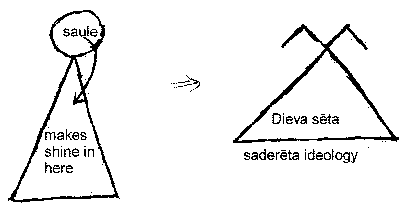|
Story of Sun [Saules Teiksma]
The ancient story of the sun is absolutely complete and rich in Latvian folklore. It is approximately 4000 years old, as old as the Latvian language itself. Latvian and Lithuanian are the oldest living languages. They are of Baltic origin, and the original words resemble Sanskrit. These are words about nature, the cosmos, and its personified characters, which we call dieviņi. The teiksma of the sun is a celestial wedding. Spīdekļi [things that sparkle] in the sky are personified, and their movement and interaction in the sky resembles the struggles and balances in nature. They explain our primary motive to grow where by our life essence (saule) has to be nurtured by appropriate work The story reveals how difficult this is to do.  (Dieva from the ancient word „shining”.) Story summary
Saule as a maiden and Mēness [moon] as suitor. They court, and Saule becomes wife with Mēness. Saule and Mēness had many offspring, the stars. The marriage is not harmonious. When Mēness misbehaves, Saule scolds him using silver stump, silver pebble or anything that sparkles as part of nature, thereby representing Visuma. Symbolically, Saule believes Mēness is not in balance with Visuma [the whole]. When Mēness is adulterous, Saule uses a sharp sword. Symbolically using the sword, she hurts him with something he made himself. In daily life, Saules Meitas [daughters of sun] apparel and activities are described. They are often joined by Dieva Dēli [son’s of god]. As explained in sēta ģimeme, these are dieviņi, and are not exclusively separate identities. In springtime, Dieva dēli look for future brides – Saules meitas. The suitors of Saules meitas can be any Dieva dēli like Auseklis [morning star], Pērkons [thunder], Ūsiņš, Mēness [moon] or human lad. (Mēness is being adulterous, no incest is implicated). A marriage agreement is made with relatives from both parties present. The wedding is in the fall and is very extravagant and detailed. The relatives of Dieva dēli sing songs of joy, while relatives of Saules meitas, sing songs of sorrow and loss. After the wedding, Saule is sorrowful. This coincides with nature’s shortened days and overcast skies. Saule is sad because she misses daughter, regrets loss of dowry, but most important, she fears Saules meita in extreme danger, either drowned or dead. Saule sheds tears which are red berries, found in far away places, like across river, other side of mountain, or middle of sea. (Red represents biological fertility). Saule sheds tears at losses. Loss of golden apple (representing spirit of life), silver boat or damaged carriage (representing spirit of constructive work). She cries when a green leaf is torn off a tree from the wind (representing difficulties growing within natures balance) and silk sheets drenched by the rain (representing hard work that goes for not). SSS2004 Home |